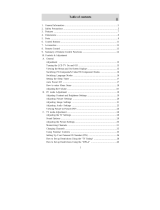
English
Symbol Press Important Note One-Touch
Button
Contents
GENERAL INFORMATION
List of Features .................................................................................. 2
Accessories........................................................................................ 2
Viewing the Control Panel.................................................................. 3
Viewing the Connection Panel ........................................................... 4
Remote Control .................................................................................. 6
Installing Batteries in the Remote Control ......................................... 7
CONNECTIONS
Connecting VHF and UHF Antennas ................................................. 7
Connecting Cable TV ......................................................................... 8
Connecting a VCR ............................................................................. 9
Connecting an S-VHS VCR ............................................................... 9
Connecting a Camcorder
(LN32R71B/LN40R71B)
............................... 10
Connecting a DVD Player .................................................................. 10
Connecting a DVD Player/Set-Top Box via DVI ................................ 10
Connecting a DVD Player/Set-Top Box via HDMI ............................. 11
Connecting an Amplifier/DVD Home Theater .................................... 11
Connecting a PC................................................................................ 12
OPERATION
Turning the TV On and Off ............................................................... 13
Plug & Play Feature ........................................................................... 13
Changing Channels ........................................................................... 14
Adjusting the Volume ......................................................................... 14
Viewing the Display............................................................................ 15
Viewing the Menus............................................................................. 15
Memorizing the Channels .................................................................. 16
To Select the Source (depending on the model) ............................... 17
To Edit the Input Source Name (depending on the model) ............... 17
PICTURE CONTROL
Using Automatic Picture Settings ................................................. 18
Adjusting the Color Tone .............................................................. 19
DNIe Demo (Digital Natural Image engine).................................. 19
Changing the Screen Size............................................................ 20
Freezing the Picture ..................................................................... 21
Viewing Picture-in-Picture............................................................. 21
SOUND CONTROL
Customizing the Sound ................................................................ 23
Using Automatic Sound Settings ................................................. 23
Setting the TruSurround XT.......................................................... 23
Choosing a Multi-Channel Sound (MTS) track ............................ 24
Automatic Volume Control ............................................................ 24
Selecting the Internal Mute........................................................... 24
Listening to the Sound of the Sub (PIP) Picture .......................... 25
Resetting the Sound Settings to the Factory Defaults ................. 25
Connecting headphones............................................................... 25
CHANNEL CONTROL
Setting the Channel Manager....................................................... 26
Activating the Child Lock ............................................................. 27
Fine Tuning Analog Channels....................................................... 28
PC DISPLAY
Using Your TV as a Computer (PC) Display ................................ 29
Display Modes .............................................................................. 29
Setting up the TV with your PC .................................................... 30
TIME SETTING
Setting the Clock .......................................................................... 32
FUNCTION DESCRIPTION
Selecting a Menu Language......................................................... 34
Setting the Blue Screen Mode...................................................... 34
Setting the On/Off Melody ............................................................ 35
Digital Noise Reduction ................................................................ 35
Using the Game Mode.................................................................. 35
Viewing Closed Captions (On-Screen Text Messages)
................ 36
Using the Energy Saving Feature ................................................ 37
Using the Color system Feature................................................... 37
APPENDIX
Identifying Problems .................................................................... 38
Installing the Stand ....................................................................... 39
Disconnecting the Stand............................................................... 39
Installing the Wall Mount Kit (LN26R71B) .................................... 40
Installing the Wall Mount Kit (LN32R71B/LN40R71B) ................. 41
Using the Anti-Theft Kensington Lock .......................................... 42
Specifications................................................................................ 42
English-1
BN68-00998E-00Eng.qxd 7/14/06 10:32 AM Page 1





















